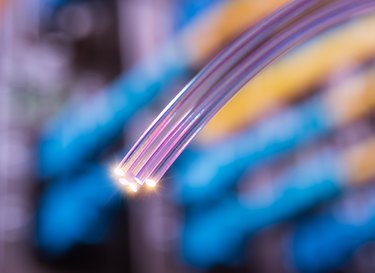
Multimode and single-mode fiber optic cables differ greatly in their design and purpose. While both cables use the same basic principles, each has its own advantages and disadvantages that make them ideally suited for a particular environment. Learning when it is appropriate to use each is critical for properly configuring a fiber-optic network, as using them in the wrong circumstance can be a costly mistake.
Single-Mode Fiber Optic Cable
Video of the Day
Single-mode fiber optic cable is designed to carry a single wavelength of light, known as a "mode." Single-mode cables use lasers as a light source, and they are typically used in long-distance telecommunication applications by phone and television companies. You can also find single-core cables used as sources of decorative illumination, as they can project light in a specific pattern. With a core diameter of only 10μm, single-mode fiber optic cables are much smaller than the multimode variety.
Video of the Day
Multimode Fiber Optic Cable
Multimode fiber-optic cables have thicker diameters than single-mode cables because they contain fibers of varying thickness. These fibers enable the cable to carry light of multiple wavelengths. Because they do not require light of a specific wavelength, they can use a light-emitting diode as a light source. You will find multimode cables used most often in a single building, both because of its ability to carry multiple wavelengths of light and because it can use inexpensive, non-industrial light sources.
Advantages and Disadvantages of Single-Mode Cable
Single-mode cable is more expensive to produce and operate than multimode cable, but it is much faster. The lasers that single-mode cables require are very expensive, and can only be used with one cable at a time. This dependency on lasers means that single-mode cable is less versatile than multimode, and is limited in its applications. However, single-mode cable is capable of transmitting data at up to 40GB over hundreds of kilometers with little integrity loss. Over greater distances, into the thousands of kilometers, this type of cable can send data at speeds of up to 10GB.
Advantages and Disadvantages of Multimode Cable
Multimode cables are less expensive to operate, install and maintain than single-mode cables. However, they are much more limited in both speed and distance. For instance, the maximum speed of a multimode cable is 10GB, but only up to a distance of 300 meters. Up to 2 kilometers, it is only capable of transmitting at 100Mbit. Beyond that, its transfer speed becomes negligible. This limitation is negated by the fact that its maximum speed is sufficient for the environment that it is most often used in.